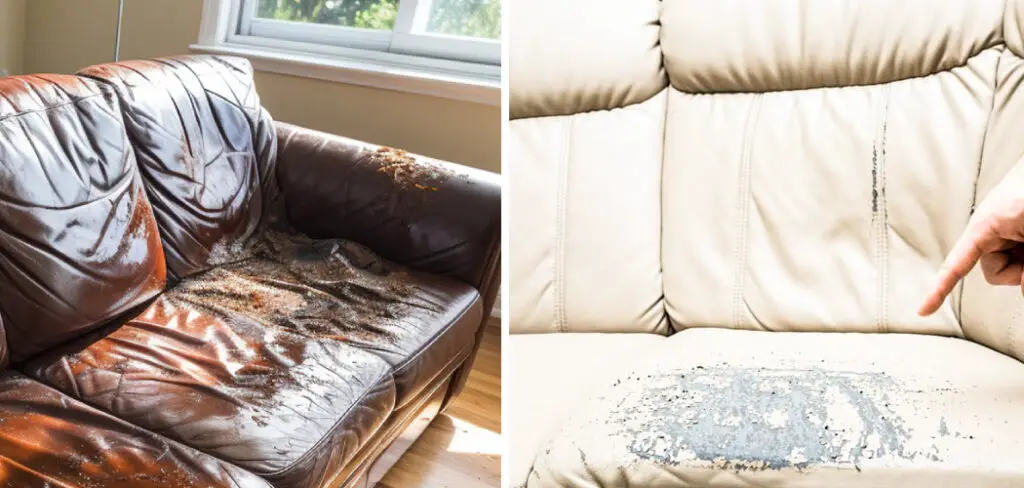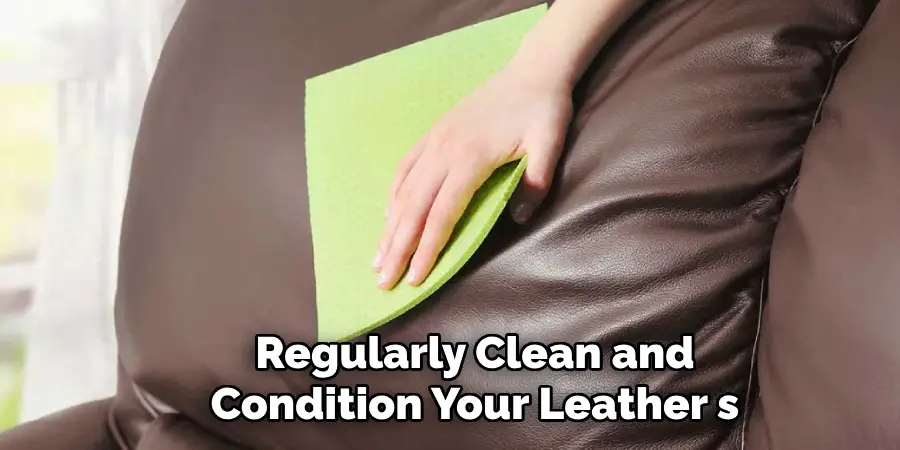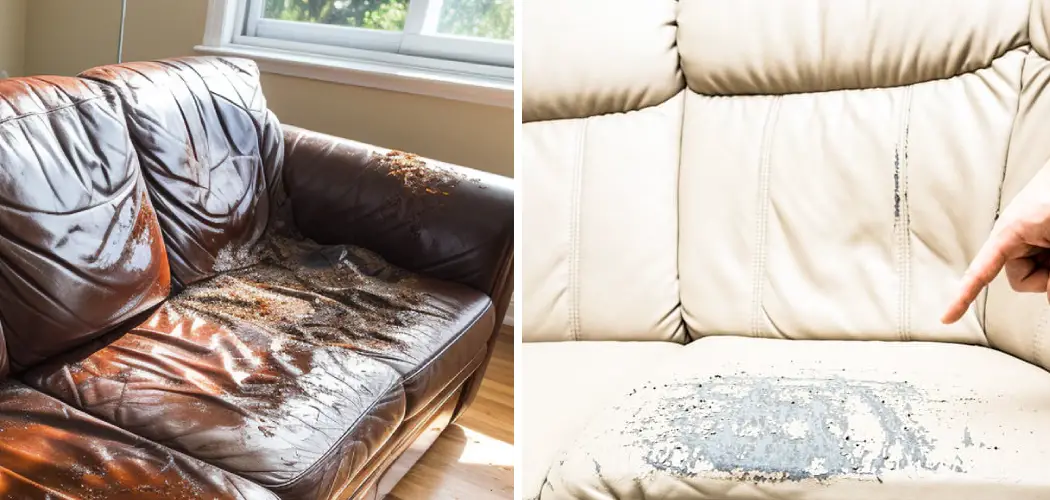Are you feeling frustrated over the damage to your beloved leather chair? After years of being an elegant addition to your home, is it starting to show signs of wear and tear with its peeling finish? You don’t have to throw out your high-quality chair yet. With a few simple steps that take minimal time and effort, you can restore its beauty so long as the damage hasn’t gone too far!

In this blog post, we’ll provide helpful tips on how to fix leather chair peeling in no time. Read on to learn more about preserving the durability of leather furniture safely!
Necessary Items
Before we get started, we must know the necessary items for this task. The good news is you already have most of them in your home! Here’s a list of what you’ll need:
- Leather cleaner and conditioner (or vinegar and linseed oil)
- Soft cloths or sponges
- Fine grit sandpaper
- Leather patch or filler (optional)
- Leather dye or paint (optional)
10 Steps on How to Fix Leather Chair Peeling
Step 1: Clean the Chair
The first step in fixing a peeling leather chair is to clean it thoroughly. Removing any dirt, dust, and grime that may have accumulated on the surface over time is important. Depending on what you have at home, use a leather cleaner and conditioner or make your solution by mixing equal vinegar and linseed oil.
Using a soft cloth or sponge, apply the cleaning solution onto the chair in circular motions, covering all areas. Let it sit for a few minutes before gently wiping it off with another clean cloth.
Step 2: Sand the Peeling Area
Using fine-grit sandpaper, gently sand the peeling area to remove loose or flaking bits. This will create a smooth surface and help the repair materials adhere better. Be careful not to sand too hard, which may further damage the leather.

Step 3: Apply Leather Filler (Optional)
If your chair has deep cracks or holes, you can use a leather patch or filler to fix them. Follow the manufacturer’s instructions on how to apply the product, and let it dry completely before moving on to the next step.
Step 4: Smooth Out the Filler (Optional)
Use fine-grit sandpaper to smooth out the filled area if you apply leather filler. This will help blend it with the rest of the chair and create a seamless finish.
Step 5: Apply Leather Dye or Paint (Optional)
You may need a leather dye or paint to restore the color and finish for chairs with severely damaged areas. Be sure to choose a product that matches the original color of your chair. Using a sponge or brush, carefully apply the dye or paint in thin layers, building up until you achieve the desired coverage.
Step 6: Let it Dry
After applying any optional repair materials, let them dry completely before moving on to the next step.
Step 7: Apply Leather Conditioner
Now that your chair is clean and repaired (if necessary), it’s important to moisturize the leather to prevent further peeling. Apply a leather conditioner or a mixture of vinegar and linseed oil in circular motions, covering all areas.
Step 8: Buff the Chair
Using a soft cloth, gently buff the chair to remove any excess conditioner and give it a shiny finish.
Step 9: Let it Set
Let your leather chair sit for at least an hour before using it. This will allow time for the repair materials and conditioner to settle fully.
Step 10: Maintain Regularly
Prevention is always better than cure, so regularly clean and condition your leather chair to keep it in top shape. Avoid placing it directly in sunlight or near heating sources, as this can dry out the leather and cause peeling.

These simple steps allow you to fix a peeling leather chair and restore its beauty easily. Always check the manufacturer’s instructions before using any products on your chair, and regularly maintain it to prevent future damage. With proper care, your leather chair can continue to be a stylish and durable addition to your home for years.
8 Care Tips for Your Leather Chair
1. Wipe Your Leather Chair Regularly
Regularly wipe your leather chair with a soft cloth or sponge to prevent dirt and grime buildup. This will also help maintain its shine.
2. Avoid Using Harsh Chemicals
Harsh chemicals can damage the finish of your leather chair, so avoid using them during cleaning or repair. Stick to gentle, leather-safe products or natural alternatives such as vinegar and linseed oil.
3. Keep Away from Direct Sunlight and Heat Sources
Direct sunlight and heat can cause the leather to dry out, leading to peeling. Keep your chair away from windows or heating sources, or use curtains or blinds to block the sun.
4. Blot Spills Immediately
Accidents happen, but quick action can prevent them from turning into stains. If something spills on your leather chair, gently blot it with a clean cloth to soak up the excess liquid.
5. Avoid Sharp Objects
Be mindful of sharp objects around your leather chair as they can easily scratch or puncture the surface, causing damage. Keep them away, or use protective covers if necessary.
6. Rotate and Flip Cushions
To prevent uneven wear, rotate and flip the cushions on your leather chair regularly. This will help distribute weight and prolong its lifespan.
7. Use Leather Conditioner at Least Twice a Year
Leather conditioner helps keep the leather supple and prevents it from drying out and cracking. Make sure to regularly condition your chair at least twice a year or more if it gets heavy use.
8. Seek Professional Help for Major Damage
If your leather chair has major damage and you are uncomfortable fixing yourself, don’t hesitate to seek professional help. A leather specialist can provide the best solutions for your situation and ensure your chair’s proper care.
Proper maintenance and regular upkeep are key to keeping your leather chair looking great and lasting for years to come. With these tips and the steps to fix a peeling chair, you can give your furniture the care it deserves. So, don’t let a little peeling discourage you from enjoying your beautiful leather chair – with a little TLC, it can be as good as new.

Frequently Asked Question
Can I Use Any Type of Leather Cleaner or Conditioner on My Chair?
It’s best to stick to products specifically designed for leather. Harsh chemicals or cleaners not made for leather can damage the finish and cause peeling. Always check the manufacturer’s instructions and test a small, inconspicuous area before using new products.
How Often Should I Clean and Condition My Leather Chair?
It depends on how often you use your chair and the level of dirt or grime it comes into contact with. Generally, it is recommended to clean and condition at least twice a year. However, if your chair gets heavy use, you may need to do it more frequently.
What Should I Do If the Leather on My Chair Is Fading or Discolored?
Use a leather dye or paint specifically made for furniture if your leather is fading or discolored. Make sure to choose a color that closely matches your original leather. Test it on a small area first and build it in thin layers for best results.
Can I Use Olive Oil or Other Natural Oils on My Leather Chair?
While natural oils like olive oil may provide some temporary shine, they can damage the leather over time by causing it to become dry and brittle. Stick to products specifically designed for leather care.
How Long Do Leather Chairs Typically Last?
The lifespan of a leather chair can vary depending on its quality, usage, and maintenance. Generally, you can expect a good quality leather chair to last 10-15 years with proper care and regular maintenance.
What Should I Do If My Leather Chair Has Deep Scratches or Tears?
For deep scratches or tears, it’s best to seek professional help. A leather specialist can provide the best solutions for your situation, whether repairing or replacing damaged areas.
How Can I Prevent My Leather Chair from Peeling in the Future?
To prevent peeling, regularly clean and condition your leather chair, keep it out of direct sunlight and heat sources, and avoid using harsh chemicals or sharp objects. Regular maintenance and proper care are key to preventing future damage.

Conclusion
In conclusion, a peeling leather chair may seem like a lost cause, but with the right knowledge and tools, you can easily fix it and prevent future damage. Regularly condition your chair, avoid harsh chemicals and direct sunlight, and seek professional help for major damage. With these tips and care tips on how to fix leather chair peeling in mind, your leather chair will continue to be a stylish and durable addition to your home for years to come.
So, don’t let a little peeling discourage you from enjoying your beautiful leather chair – with proper care and maintenance, it can be as good as new! Always refer to the manufacturer’s instructions and seek professional help when needed. Happy caring for your leather chair!

